 home
home
 back
back
The basic diffence between balanced and unbalanced signal lines is how the return current path is handled:
| unbalanced | return current passes back through screen (or shield) |
| balanced | return current passes through separate line with the send and return as a twisted-pair cable |
This makes balanced lines much less susceptible to induced noise. Most telephone systems don't use screened cable for their signal distribution and yet they are extremely quiet, considering the length of cabling and the environment they work in. This is because they use balanced lines.
Any external noise is induced identically onto each leg of the twisted pair i.e. the same noise gets onto both conductors in the pair at the same level and same phase. The differential input stage of the input fed by the balanced line only looks at the difference between the two legs. Thus noise is effectively ignored.

The red trace is the signal hot, the blue is the signal cold and the white trace is the difference between the two. So the spike which appears equally on both traces is not seen by the input stage.
The degree of rejection by a differential input stage is called common mode rejection ratio or CMRR and is expressed as a ratio in dB which is the effective rejection of such noise.
Typically balanced lines drive into lower impedances than unbalanced lines which make them even less suseptible to noise. This is due to the signal current being higher and thus induced noise which is typically high voltage-very low current have lees effect. Tranformers are entirely current dependant devices and so form the basis of high quality input stages. Transformers can also serve to isolate the signal lines from the signal ground and offer yet more ways to reduce noise.
See also signal grounding and interfacing balanced and unbalanced systems